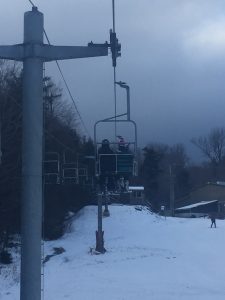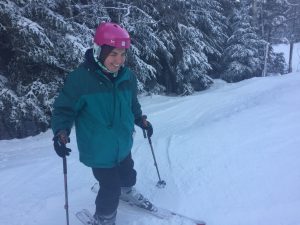It’s a typical sleepover in my sleepy, rural Ohio town. I’m at a friend’s house and have been assigned the task of fetching ice cream from the garage. I push open the freezer chest and smell it before I see it. The scent is sour and vaguely metallic. The source: a dismembered deer carcass/definitely not ice cream. Hunting was not uncommon growing up. During school, the boys wore their camouflage hats and on walks in my backyard woods, I’d often find shotgun shells. In the spring, the sounds of lawn mowers and mail trucks were punctuated by my neighbor’s shotgun. Although I had never actually been hunting, I considered myself more knowledgeable than the average person on the matter. When I sat down with Rocci Aguirre and Emily Liebelt from Adirondack Council and avid hunter and Saratoga County Director of Planning Jason Kemper, I was overly confident of my baseline knowledge on the culture, rules, and appeal surrounding hunting. Here were my biggest misconceptions:
1.It’s just a leisure activity that people do for fun.
There is a cultural identity that is associated with hunting, particularly in a place like the Adirondacks that contains multigenerational hunting camps. “Hunting is a really important piece culturally for these rural communities,” says Aguirre. He labels people who identify a core cultural value with hunting as “lifestyle hunters.” Kemper shared similar views, calling hunting “a way of life.” This way of life tends to be passed from generation to generation. “Dad did it. Grandfather did it,” says Kemper. “Hunting camps are epicenters of coming of age,” says Liebelt. “It’s a glue for some of these families, and is bigger than just hunting.” The act of hunting, which sometimes involves literally sitting on a small square for eight hours, can foster a “real identity and bond of that shared experience. It’s camaraderie built through hardship,” says Aguirre.
It is true that not all hunters are “lifestyle hunters.” Aguirre and Liebelt use “forest to fork” hunters as an example of people who participate in the activity, but for perhaps different reasons. But as Liebelt describes, for many people in the Adirondacks, hunting can be used to understand and contextualize the world around them: “Hunting is their metaphor for life.”
2. It’s all about the kill.
I was surprised to hear from both Aguirre and Kemper that hunting, for them, is not centered around killing their prey. “For me, I just like being outside,” says Kemper. A lot of the time when he hunts, he doesn’t even end up killing an animal. For Aguirre, “it’s really about understanding the ever changing puzzle.” Aguirre explains the intense study of the natural world required for hunting. “You have to pay attention to wind to noise to weather. Hunting is not how much you take off the land, but how much you interface with the land.”
That being said, although for Kemper and Aguirre, bagging game isn’t the primary reason for hunting, Aguirre warns that ”the killing part should always be something you’re conscious of. I’m always grateful for the gifts that are given, and I take time out of the process to acknowledge the spirit of the thing I’m trying to harvest.”
3. Hunting in other places is the same as hunting in the Adirondacks.
Prior to speaking with Kemper and Aguirre, I had a singular vision of what hunting was: sitting in a tree stand, wearing camo, for hours upon hours. Yes, this sort of hunting does exist, but the Adirondacks are appealing for a totally different form of hunting. According to Aguirre, the low deer density due to the forest type in the Adirondacks promotes a rugged hunt that requires tracking and following deer. “If it snows, you’re tracking deer and carrying it out for miles.” This particular brand of hunting is “unique to the Adirondacks, and brings a lot more tourism than people think,” says Aguirre.
4. You just shoot it and take it home, no problem!
Wrong! “There are so many checks and balances in place,” says Kemper. First, you must have a hunting license, which requires not only an annual fee, but the passage of an educational course. There are additional permits and privileges that cost money, such as bow hunting and deer management permits. Once you have your license, there are limits on how much and when you can harvest. Kills must be reported to the DEC, or else you can lose your license. If you wish to sell a pelt, you need a DEC stamp approving it.
All of these regulations seem great, but I was curious as to whether hunters abide by them. Kemper informed me that violations occur everywhere, not just the Adirondacks. “A couple of bad apples ruin it and take away from the reputation of other hunters.” The same could be said of any form of recreation. “It’s no different than having a party on top of Marcy,” he says. Kemper also points out the fact that “the sporting community pays for the officers that patrol us.”
In conclusion, let’s be open!
During our conversation, Kemper mentioned problems facing hunting education courses. “We have the lowest hunting related incident rates in the nation,” he says. New York State puts so much emphasis on safety, and the courses are packed. However, anti-hunters will sign up for courses and not show up the day of the class, simply to prevent others from attending. To me, it’s sad that people seek to prevent adults and kids from safely learning about a culturally rich recreational activity that not only brings people into the outdoors, but teaches them to really observe and study the natural world around them. Kemper suspects that anti-hunters exist due to “a lack of understanding.” Aguirre says, “people always place their own value judgments on the act of hunting…and all that does is make you defensive.” I don’t think it’s possible to eliminate value judgments, but at the very least, we can gather information by listening openly to make the most informed decisions.

